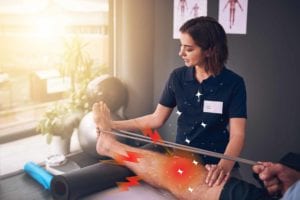

Opioid medication can work wonders for severe pain, but these medications (such as Vicodin, codeine, and morphine) also carry a risk of side effects, some of which can be serious. Of particular concern is the growing opioid addiction (and overdose) epidemic, as some people who start out with a legitimate prescription for an opioid to treat pain end up abusing these medications and turning to illegal opioids like heroin. The CDC estimates that 130 people in the U.S. die every day after overdosing on an opioid.
To stem this alarming trend, health experts have been encouraging physicians to scale back on prescribing opioids and encourage most patients with chronic pain issues to rely on other types of medications and non-drug approaches to treat their pain instead.
One non-pharmacological tool that seems to be making a big difference: physical therapy.
According to a new study, published in JAMA Network Open, people who started physical therapy soon after developing shoulder, knee, or low back pain had a 10 percent reduction in their use of opioid medication. In a given patient, that might mean not using opioids at all, using them at a lower dose, or taking them for a shorter period of time.
These study findings were derived from an analysis of health insurance claims filed between 2007 and 2015. They included data on 88,985 patients who were recently diagnosed with musculoskeletal pain. None of them had tried opioids before the beginning of the study.
If you’ve recently developed shoulder, knee, or back pain, ask your doctor if physical therapy is worth a try. If you still end up needing opioids, be sure to communicate closely with your doctor and only use the medication as directed. To avoid the risk of addiction and overuse, aim to take the lowest effective dose for the shortest amount of time possible.
Keep Reading
- A New (Non-Opioid) Kind of Drug for Knee and Hip Pain May Be a Gamechanger
- Marijuana for Fibromyalgia Pain: Is It Worth a Try?
- Non-Drug Treatments for Back Pain Work — But Your Insurance Might Not Cover Them





